The Biology Laboratory Manual 12th Edition is a comprehensive resource for introductory biology courses, blending theoretical concepts with practical experiments to enhance student understanding and lab skills effectively.
1.1 Overview of the Manual
The Biology Laboratory Manual 12th Edition by Darrell S. Vodopich and Randy Moore is a comprehensive guide designed for introductory biology courses. It provides a broad survey of basic laboratory techniques, covering essential topics such as cell biology, genetics, evolution, microbiology, and ecology. The manual includes detailed experiments, procedures, and resources to enhance hands-on learning. With a focus on practical applications, it bridges theory and practice, offering students a structured framework to develop their scientific skills and understanding of biological principles effectively.
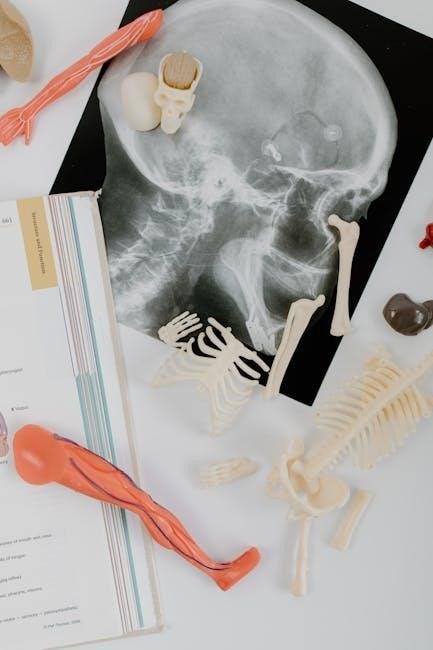
1.2 Key Features of the 12th Edition
The 12th Edition of the Biology Laboratory Manual stands out with its updated experiments, alignment with modern biology curricula, and enhanced digital resources. It incorporates interactive simulations, multimedia content, and online supplements to enrich the learning experience. The manual emphasizes critical thinking and problem-solving through structured lab procedures, ensuring students develop practical skills and a deeper understanding of biological concepts. Additionally, it provides test banks, assessment tools, and instructor guides, making it a versatile and comprehensive resource for both students and educators in introductory biology courses.
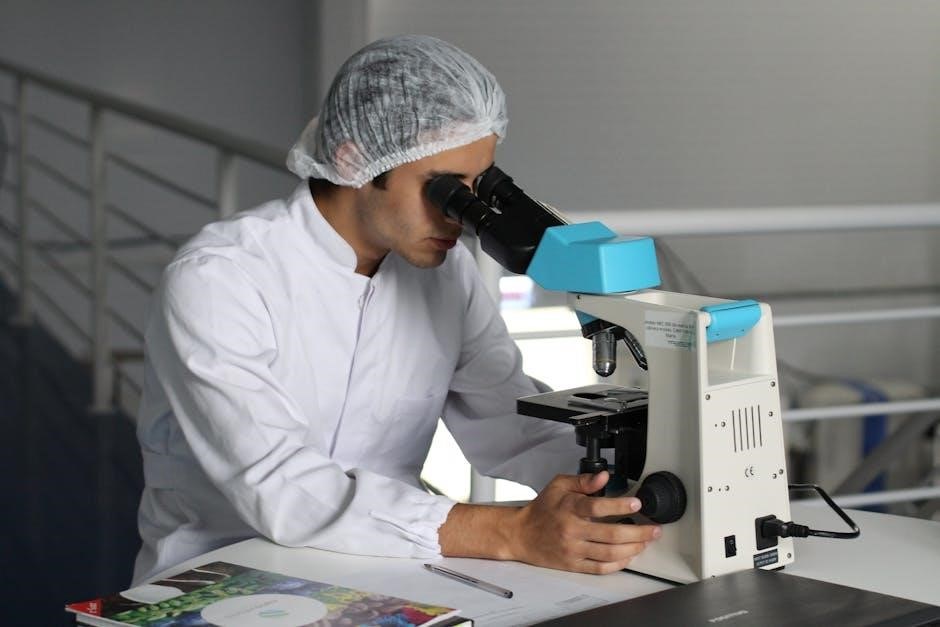
1.3 Importance of Lab Manuals in Biology Education
Lab manuals like the Biology Laboratory Manual 12th Edition are essential for fostering hands-on learning and practical skills in biology education. They provide structured experiments and procedures that bridge theoretical knowledge with real-world applications, ensuring students grasp complex biological concepts effectively. By emphasizing critical thinking, data analysis, and problem-solving, lab manuals prepare students for advanced studies and careers in science. They also standardize learning experiences, ensuring consistency and comprehensive understanding across diverse educational settings, making them indispensable tools in modern biology education.
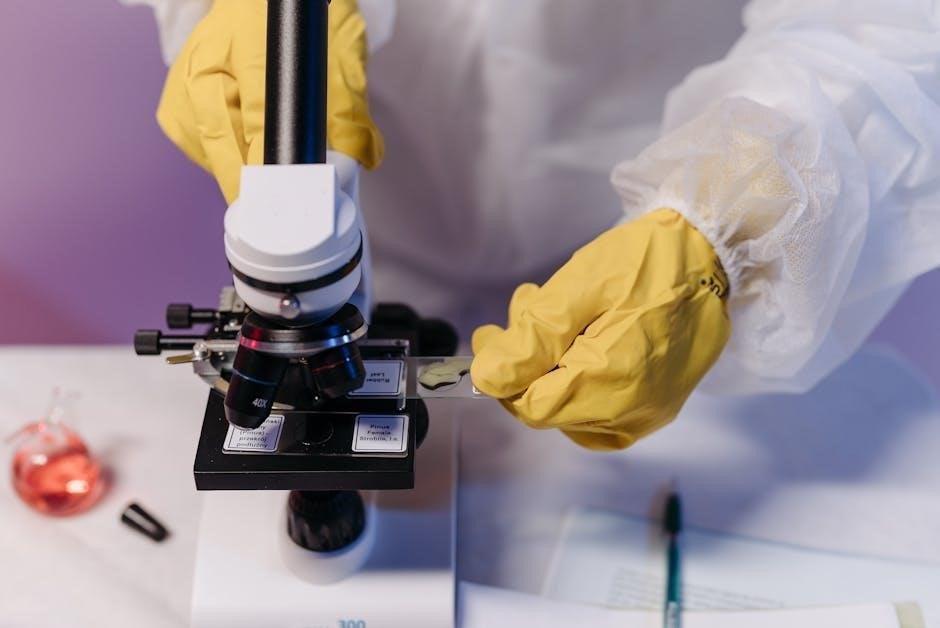
Structure and Organization of the Manual
The Biology Laboratory Manual 12th Edition is organized into eight logical parts, each focusing on key biological concepts, ensuring a clear and progressive learning experience for students.
2.1 Part 1: The Cell
Part 1 of the Biology Laboratory Manual 12th Edition focuses on the cell, introducing foundational concepts of cell structure, function, and processes. Experiments explore cell transport mechanisms, cellular respiration, and eukaryotic cell structure using microscopy. Students gain practical experience with cell fractionation and enzyme activity analysis. Interactive simulations supplement lab work, enhancing visualization of cellular processes. This section emphasizes hands-on learning to reinforce theoretical knowledge, ensuring a solid understanding of cellular biology principles essential for advanced studies. Clear instructions and safety protocols are provided to guide students through experiments effectively.
2.2 Part 2: The Genetic Basis of Life
Part 2 delves into the genetic basis of life, exploring DNA structure, mutations, and Mendelian genetics. Experiments include DNA isolation, PCR, and genetic crosses to illustrate inheritance patterns. Interactive simulations model DNA replication and protein synthesis, enhancing understanding. Data analysis exercises reinforce concepts of genetic probabilities and evolutionary changes. This section integrates theoretical knowledge with practical techniques, preparing students to apply genetic principles in real-world scenarios. Clear instructions and multimedia resources support immersive learning, fostering a deep appreciation of genetics’ role in life processes and biological diversity.
2.3 Part 3: Evolution
Part 3 focuses on evolution, exploring natural selection, fossil records, and comparative anatomy. Hands-on experiments simulate evolutionary processes, such as speciation and adaptation. Data analysis exercises involve interpreting phylogenetic trees and calculating genetic drift. Interactive simulations model population dynamics and evolutionary timelines. Case studies on real-world examples, like antibiotic resistance, illustrate evolutionary principles. This section emphasizes critical thinking and evidence-based reasoning, helping students understand evolution’s role in shaping biodiversity and life’s complexity. Multimedia resources and lab activities deepen comprehension of this foundational biological concept.
2.4 Part 4: Microbiology and Evolution
Part 4 delves into microbiology, linking microbes’ evolution to broader biological principles. Experiments include culturing, staining, and identifying microorganisms, with a focus on their evolutionary adaptations. Activities explore antibiotic resistance, symbiotic relationships, and microbial ecology. Interactive simulations model microbial growth and evolutionary responses to environmental changes. This section integrates lab work with theoretical understanding, highlighting microbes’ roles in ecosystems and human health. Practical exercises and digital resources enhance students’ appreciation of microbiology’s significance in evolutionary biology.
2.5 Part 5: Plant Evolution and Biology
Part 5 explores plant evolution and biology, focusing on the diversity of plant life and their adaptive strategies. Experiments include analyzing plant morphology, studying photosynthesis, and investigating plant growth regulation. Activities emphasize the evolutionary relationships among plants, from algae to flowering plants. Interactive simulations illustrate processes like seed dispersal and pollination. This section integrates hands-on investigations with theoretical concepts, providing a deeper understanding of plant biology and its role in ecosystems. Digital resources and lab exercises enhance learning, connecting plant evolution to broader biological principles.
2.6 Part 6: Animal Evolution and Diversity
Part 6 delves into the evolution and diversity of animals, tracing the phylogenetic relationships and adaptations of major animal groups. Experiments focus on comparative anatomy, developmental biology, and behavioral studies. Labs include dissections, observations of live specimens, and analyses of fossil records. Digital resources provide interactive phylogenetic trees and simulations of evolutionary processes. This section emphasizes the importance of understanding animal diversity in the context of ecological and evolutionary principles, preparing students for advanced studies in zoology and conservation biology.
2.7 Part 7: Comparative Animal Biology
Part 7 focuses on comparative animal biology, exploring the structure, function, and behavior of diverse animal species. Experiments emphasize comparative anatomy, physiological systems, and evolutionary adaptations. Students analyze organ systems, developmental processes, and behavioral traits across species. Labs incorporate dissection, microscopy, and data analysis to deepen understanding of animal biology. Digital resources, such as interactive simulations and 3D models, enhance learning. This section bridges theoretical knowledge with practical skills, fostering insights into animal diversity and evolutionary adaptations.
2.8 Part 8: Ecology
Part 8 focuses on ecology, offering hands-on experiments to explore interactions between organisms and their environments. Labs cover population dynamics, community interactions, and ecosystem processes. Students engage in field and laboratory studies, analyzing data to understand ecological principles. Topics include energy flow, nutrient cycling, and human impacts on ecosystems. Practical applications such as water quality assessment and soil analysis are emphasized. This section fosters critical thinking about environmental challenges and promotes an appreciation for conservation and sustainability in ecological systems.

Experiments and Procedures
Experiments and Procedures in the Biology Laboratory Manual 12th Edition cover cell biology, genetics, evolution, microbiology, plant biology, animal physiology, and ecology, blending theory with practical applications.
3.1 Cell Biology Experiments
The Biology Laboratory Manual 12th Edition includes detailed cell biology experiments, such as observing cell structure, membrane transport, and mitosis. These activities provide hands-on experience with microscopy and staining techniques, enabling students to visualize cellular components and processes. Experiments are designed to reinforce concepts like the cell cycle, photosynthesis, and cellular respiration, offering a practical understanding of cellular function and its role in life processes.
Students engage in activities that explore the dynamics of cellular biology, from osmosis and diffusion to DNA extraction, fostering critical thinking and laboratory skills essential for advanced study in the field.
3.2 Genetics and Biotechnology Techniques
The 12th Edition manual includes experiments on genetics and biotechnology, such as DNA extraction, PCR, and gel electrophoresis. These activities introduce students to modern molecular biology techniques, emphasizing hands-on experience with genetic analysis tools. Experiments like genetic crosses and pedigree analysis reinforce Mendelian inheritance principles, while others explore CRISPR and gene editing, preparing students for cutting-edge applications in biotechnology and genetic engineering.
These exercises foster a deep understanding of genetic principles and their practical applications in medicine, agriculture, and research.
3.3 Evolution and Natural Selection Studies
The 12th Edition manual features experiments exploring evolution and natural selection, such as simulations of evolutionary processes and analysis of fossil records. Students engage in hands-on activities to observe how environmental pressures influence species adaptation. These studies include investigations into comparative anatomy and phylogenetic trees, allowing learners to apply theoretical concepts to real-world examples. By examining evidence for evolution, students gain a deeper understanding of natural selection’s role in shaping biodiversity and the methods scientists use to study evolutionary changes.
3.4 Microbiology and Immunology Labs
The 12th Edition manual includes microbiology and immunology labs that explore microbial growth, aseptic techniques, and host-microbe interactions. Experiments focus on identifying unknown bacteria, studying immune responses, and understanding antimicrobial agents. Students learn to culture microorganisms, perform stains, and use microscopy to analyze specimens. These labs emphasize practical skills in microbiological procedures while fostering an understanding of the immune system’s role in combating pathogens. Hands-on activities provide real-world applications of microbiology concepts, preparing students for advanced studies in the field.
3.5 Plant Biology Investigations
The 12th Edition manual offers detailed plant biology investigations, focusing on experiments that explore plant anatomy, physiology, and ecology. Students examine plant structures, photosynthesis, and respiration processes, with labs on mitosis in root tips, stem anatomy, and the effects of hormones like auxins. Practical exercises include seed germination studies, analysis of vascular tissues, and investigations into the role of environmental factors on plant growth. These investigations enhance understanding of plant development and prepare students for advanced studies in botany and environmental science.
3.6 Animal Physiology and Anatomy Studies
The manual includes comprehensive investigations into animal physiology and anatomy, with a focus on understanding organ systems and their functions. Labs include dissections of specimens like the fetal pig, exploring the digestive, respiratory, and circulatory systems. Students also conduct experiments on reflexes, muscle physiology, and nerve responses. These studies integrate theoretical knowledge with hands-on observations, enabling a deeper understanding of animal biology and preparing learners for advanced courses in zoology, medicine, and related fields.
3.7 Ecology and Environmental Science Experiments
The manual features experiments that explore ecological principles and environmental science, emphasizing field and lab-based investigations. Students engage in biodiversity assessments, ecological sampling, and environmental impact analyses. Labs include studies on population dynamics, nutrient cycling, and the effects of human activities on ecosystems. These experiments foster critical thinking and data interpretation skills, preparing learners to address real-world environmental challenges and promote sustainability. The section underscores the importance of applied ecology in understanding and mitigating human impacts on natural systems.
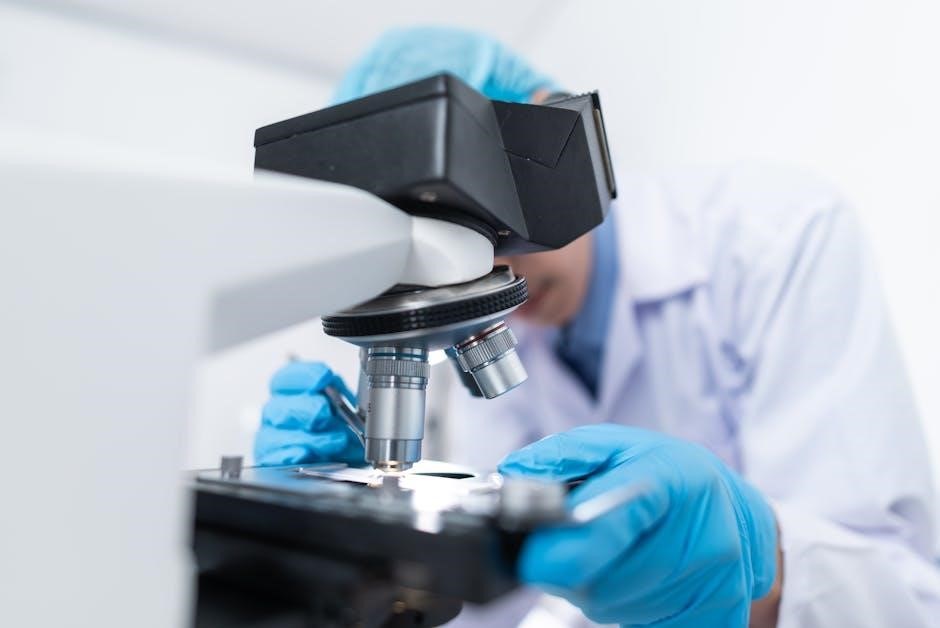
Learning Resources and Supplements
The 12th Edition offers comprehensive learning resources, including test banks, digital companions, and instructor guides, to enhance teaching and student engagement with interactive tools and additional materials.
4.1 Test Banks and Assessment Tools
The 12th Edition provides robust test banks with multiple-choice questions, ensuring comprehensive assessment of students’ understanding of biology concepts, lab procedures, and statistical calculations. These tools are designed to evaluate critical thinking and practical skills, aligning with course objectives. Instructors can access a variety of questions to create customized exams, while students benefit from self-assessment opportunities. The test banks are integrated with the manual’s content, reinforcing key concepts and experimental outcomes to enhance learning outcomes and teaching effectiveness, making them indispensable for both educators and learners in biology education.
4.2 Digital Resources and Online Companion
The 12th Edition offers a range of digital resources, including a downloadable PDF version of the manual, ensuring accessibility and convenience for students. Interactive simulations and multimedia elements enhance learning by visualizing complex biological processes. The online companion provides supplementary materials, such as virtual labs, videos, and additional practice questions, to reinforce concepts. These resources are designed to support both instructors and students, offering a flexible and engaging learning experience that complements traditional lab work and classroom instruction effectively.
4.3 Instructor’s Guide and Lab Manual Solutions
The Instructor’s Guide accompanying the Biology Laboratory Manual 12th Edition provides educators with comprehensive solutions to lab exercises, detailed teaching tips, and assessment tools. This resource ensures instructors can effectively guide students through experiments and evaluate their understanding. The manual solutions are designed to align with the lab activities, offering clear answers and explanations. This guide is an invaluable tool for instructors, supporting their efforts to deliver a structured and impactful biology education experience for their students.
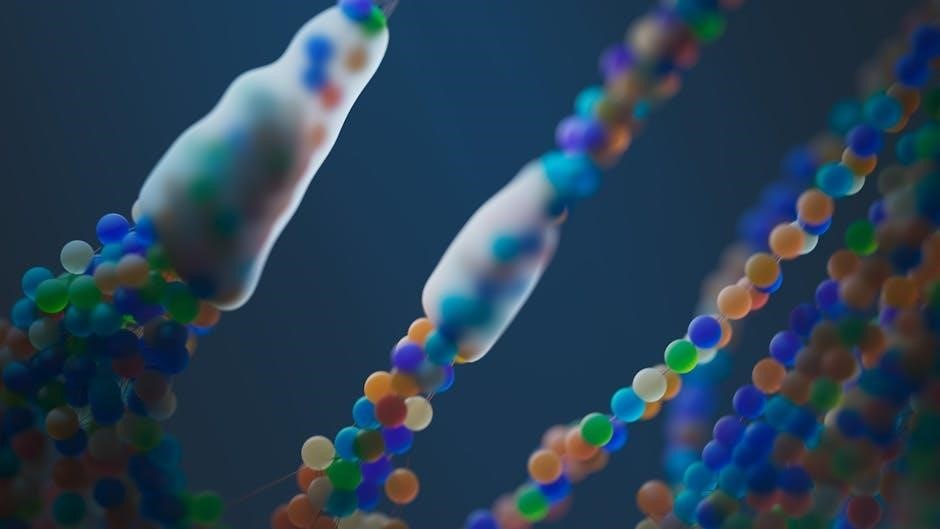
Practical Applications and Skill Development
The Biology Laboratory Manual 12th Edition enhances practical skills by applying biological concepts through detailed experiments, fostering critical thinking and problem-solving abilities in students effectively.
5.1 Development of Laboratory Skills
The Biology Laboratory Manual 12th Edition emphasizes the development of essential laboratory skills through hands-on experiments. Students master microscopy, dissection, and data collection, aligning practical techniques with theoretical concepts. The manual introduces safe handling of biological specimens and chemicals, fostering a thorough understanding of lab protocols. By engaging in structured activities, learners enhance their dexterity, precision, and ability to conduct scientific inquiries independently. These skills are foundational for advancing in biology and prepares students for more complex research in their academic and professional careers.
5.2 Critical Thinking and Problem-Solving
The Biology Laboratory Manual 12th Edition fosters critical thinking and problem-solving through engaging experiments and data-driven activities. Students analyze biological phenomena, interpret results, and draw meaningful conclusions. The manual encourages questioning and exploration, promoting a deeper understanding of scientific principles. By applying theoretical knowledge to practical scenarios, learners develop the ability to approach complex biological questions systematically. These exercises prepare students to think scientifically and address real-world challenges in biology with confidence and intellectual curiosity.
5.3 Data Analysis and Interpretation
The Biology Laboratory Manual 12th Edition emphasizes the importance of data analysis and interpretation in understanding biological concepts. Through structured exercises, students learn to collect, organize, and analyze data effectively. The manual provides tools and techniques for statistical analysis, graph creation, and result interpretation. These skills enable students to draw meaningful conclusions and communicate their findings clearly. By mastering data analysis, learners develop a stronger grasp of biological principles and their practical applications, preparing them for advanced scientific studies and real-world problem-solving scenarios.
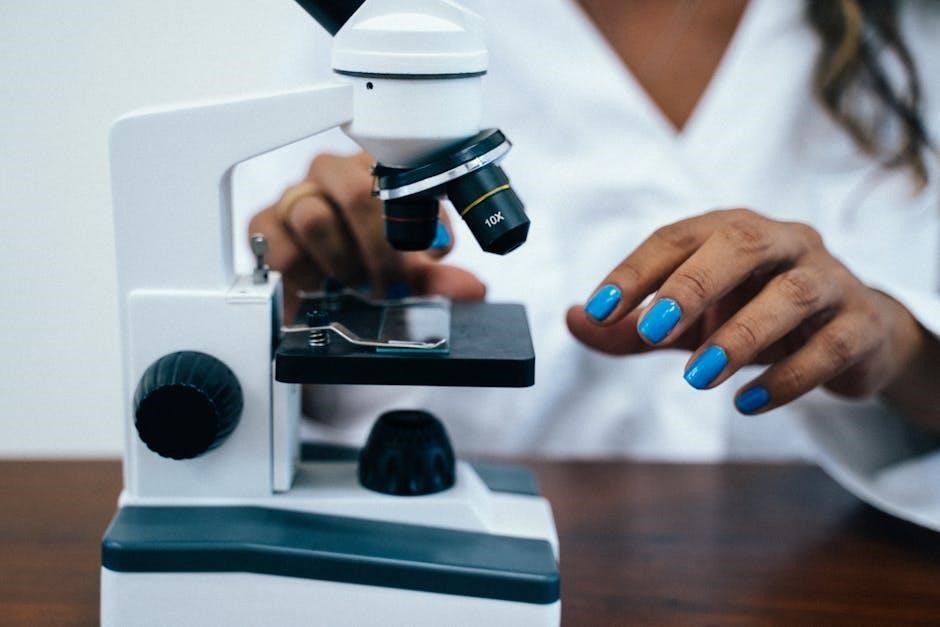
Safety and Laboratory Precautions
Safety is a priority in the Biology Laboratory Manual 12th Edition, with detailed guidelines for handling biological specimens, chemicals, and equipment. Emergency procedures and proper use of personal protective equipment are emphasized to ensure a secure learning environment for all students.
6.1 General Lab Safety Guidelines
The Biology Laboratory Manual 12th Edition emphasizes adherence to general lab safety guidelines to ensure a secure environment for students. Proper attire, including lab coats and gloves, is mandatory. Students are instructed to handle biological specimens and chemicals with care, avoiding ingestion or improper disposal. Emergency exit routes and fire extinguishers should be identified beforehand. Equipment must be used as directed, and unauthorized experiments are strictly prohibited. These guidelines are designed to minimize risks and foster a safe, focused atmosphere for learning and experimentation. Adherence is non-negotiable to protect both individuals and the lab setting.
6.2 Handling Biological Specimens and Chemicals
Proper handling of biological specimens and chemicals is crucial for safety and accuracy in lab experiments. Students should wear gloves and goggles when handling potentially hazardous materials. Biological specimens must be stored in labeled, sealed containers and disposed of according to biohazard protocols; Chemicals should be used in well-ventilated areas, and their labels followed strictly. Spills must be cleaned immediately, and unused materials returned to their storage areas. Misuse of these materials can lead to contamination or injury, emphasizing the need for adherence to established protocols. Proper techniques ensure both safety and reliable experimental outcomes. Always refer to the manual for specific guidelines.
6.3 Emergency Procedures and First Aid
In case of emergencies, prompt action is essential to ensure safety and minimize harm. For chemical spills, evacuate the area and neutralize the spill with appropriate materials. Eye or skin exposure requires immediate flushing with water for at least 15 minutes. Biological spills should be contained and disinfected. Fires should be extinguished using a fire extinguisher. First aid kits must be readily available, and injuries like cuts or burns should be treated promptly. Always alert the instructor or lab supervisor and follow established emergency protocols to ensure a safe environment for all laboratory activities and procedures.

Digital and Online Resources
The Biology Laboratory Manual 12th Edition is available as a PDF, offering interactive simulations and additional online resources to enhance learning experiences and student engagement effectively.
7.1 PDF Availability and Accessibility
The Biology Laboratory Manual 12th Edition is widely available in PDF format, ensuring easy access for students and educators. This digital version can be downloaded from various online platforms, offering flexibility for offline study. The PDF is compatible with multiple devices, including tablets, laptops, and smartphones, making it convenient for learning on the go. Additionally, the PDF format preserves the manual’s layout and content quality, providing a seamless experience for users. This accessibility ensures that students can engage with the material effectively, regardless of their location or device preferences.
7.2 Interactive Simulations and Multimedia
The 12th Edition of the Biology Laboratory Manual incorporates interactive simulations and multimedia resources to enhance learning. These tools include virtual lab experiments, 3D anatomical models, and video tutorials, providing students with immersive experiences. Interactive simulations allow users to explore complex biological processes in a controlled environment, while multimedia elements, such as animations and podcasts, cater to diverse learning styles. These features are accessible online, complementing the PDF manual and offering a dynamic approach to understanding biology concepts.
7.3 Online Supplements and Additional Materials
The 12th Edition of the Biology Laboratory Manual offers extensive online supplements, including test banks, interactive question banks, and digital resources. These materials provide additional practice problems, lab simulations, and multimedia content to enhance learning. Instructors can access an online companion with solutions, while students benefit from downloadable PDFs and interactive tools. These supplements are designed to complement the manual, offering a comprehensive learning experience that goes beyond traditional lab work, ensuring both theoretical and practical understanding of biological concepts.

Significance of the 12th Edition
The 12th Edition of the Biology Laboratory Manual is a vital resource for modern biology education, offering updated content, alignment with current curricula, and enhanced learning tools.
8.1 Updates and Revisions in the 12th Edition
The 12th Edition of the Biology Laboratory Manual introduces significant updates, including new experiments, revised lab techniques, and alignment with modern curriculum standards. Enhanced visuals, such as high-resolution micrographs and detailed diagrams, improve comprehension. Digital integration has been expanded, offering interactive simulations and online supplements. Updates also focus on emerging topics in biology, ensuring relevance and depth. Safety protocols and ethical considerations have been refined, emphasizing responsible laboratory practices. These revisions enhance the learning experience, providing students with a robust foundation for understanding biological principles and applying them in practical scenarios.
8.2 Alignment with Modern Biology Curriculum
The 12th Edition of the Biology Laboratory Manual aligns seamlessly with contemporary biology curricula, addressing key themes such as molecular biology and evolutionary principles. It incorporates recent advancements in biotechnology and genetics, ensuring students engage with cutting-edge topics. The manual’s structure mirrors standard course outlines, making it an ideal companion for structured learning. By integrating modern techniques and emphasizing critical thinking, it supports educational goals effectively, preparing students for advanced studies and real-world applications in the biological sciences.
8.3 Enhanced Learning Experience
The 12th Edition of the Biology Laboratory Manual offers an enhanced learning experience through its engaging structure and interactive features. It incorporates digital resources, multimedia simulations, and clear instructions to foster hands-on learning. The manual’s organized format ensures students can easily follow procedures, interpret data, and apply theoretical knowledge. Enhanced visuals and updated content further enrich the educational process, making complex biological concepts more accessible and stimulating for students. This edition prioritizes active learning, equipping students with practical skills and a deeper understanding of biology.
The Biology Laboratory Manual 12th Edition is a vital resource for biology education, offering comprehensive experiments and practical skills to enhance students’ understanding of biological concepts effectively.
9.1 Final Thoughts on the Manual
The Biology Laboratory Manual 12th Edition stands as a cornerstone for biology education, offering a structured approach to learning through detailed experiments and practical techniques. Its comprehensive coverage of biological concepts, from cellular biology to ecology, ensures a well-rounded understanding for students. The manual’s alignment with modern curricula and its emphasis on critical thinking and skill development make it an indispensable resource for both students and educators. By bridging theory and practice, it fosters a deeper appreciation for biological sciences and prepares learners for future challenges in the field.
9.2 Future of Biology Lab Manuals
The future of biology lab manuals lies in enhanced digital integration and interactive content, providing immersive learning experiences. With the rise of virtual labs and real-time data analysis tools, manuals like the 12th Edition will evolve to incorporate multimedia simulations and AI-driven assessments. Accessibility will improve through PDF and online formats, ensuring universal reach. These advancements will not only align with modern curricula but also cater to diverse learning styles, making biology education more engaging and effective for future generations of students and educators alike.